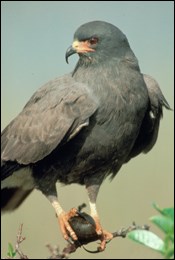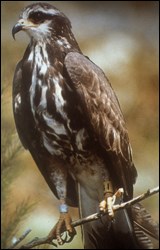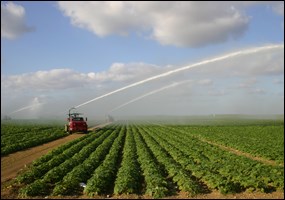
Now officially known as simply a Snail Kite, the subspecies from Florida and Cuba (Rostrhamus sociabilis plumbeus) formerly known as the Everglade Snail Kite was listed as endangered in 1967. The range of the Florida population of Snail Kites is restricted to watersheds in the central and southern part of the state. Because of a highly specific diet composed almost entirely of apple snails (Pomacea paludosa), survival of the Snail Kite depends directly on the hydrology and water quality of these watersheds, each of which has experienced pervasive degradation as a result of urban development and agricultural activities. The slender, curved bill of this medium-sized raptor is an adaptation for extracting the kite's primary prey, the apple snail, from its shell. The bill is a distinguishing characteristic for field identification of adults as well as juveniles. Although sometimes confused with the northern harrier, the Snail Kite's flight is slower and characterized by more wing flapping, and the head typically is tilted down to look for snails while in flight. Snail Kites do not plunge into the water to capture snails and never use the bill to capture prey. Rather, they use their feet to capture snails at or below the surface of the water. 
NPS photo Snail Kite habitat consists of freshwater marshes and the shallow vegetated edges of natural and manmade lakes where apple snails can be found. Snail Kites require foraging areas that are relatively clear and open so that they can visually search for apple snails. Dense vegetation is not conducive to efficient foraging. Nearly continuous flooding of wetlands is needed to support apple snail populations that in turn sustain foraging by Snail Kites. Disposal of domestic sewage through septic tanks and runoff of nutrient-laden water from agricultural lands degrade the water quality and promote dense growth of exotic and invasive plants such as cattail, water lettuce, water hyacinth, and hydrilla, thereby reducing the ability of Snail Kites to locate apple snails. Although Snail Kites in Florida are not migratory, they are nomadic in response to water depths, hydroperiod, food availability, and other changes in habitat. Shifts in distribution can be short-term, seasonal, or long-term. The ranges of the endangered Wood Stork and Cape Sable Seaside Sparrow overlap the range of the Snail Kite. Although hydrologic conditions that are more favorable to one species may not be as favorable for another species, all of these animals survived the hydrologic variability characteristic of the natural system. However, the reduced extent of suitable present-day habitat makes all of these species more vulnerable to natural as well as human-caused threats. 
NPS photo by Vincent DiFrenna The principal threat to the Snail Kite is the loss or degradation of wetlands in central and south Florida. Nearly half of the Everglades have been drained for agriculture and urban development. Everglades National Park preserves only about one-fifth of the original extent of the Everglades. The present-day system of canals, levees, and water-control structures has disrupted the volume, timing, direction, and velocity of freshwater flow. The natural sheet-flow pattern under which the Everglades evolved over the last 5,000 years no longer exists. The loss of freshwater to seepage, flood-control releases to tidal waters, and extraction for irrigation and urban water supply has led to salt-water intrusion in some places. Regulation of water stages in lakes and canals is particularly important to maintain the balance of vegetative communities required to sustain Snail Kites. ADDITIONAL RESOURCES South Florida Multi-Species Recovery Plan |
Last updated: October 17, 2017
